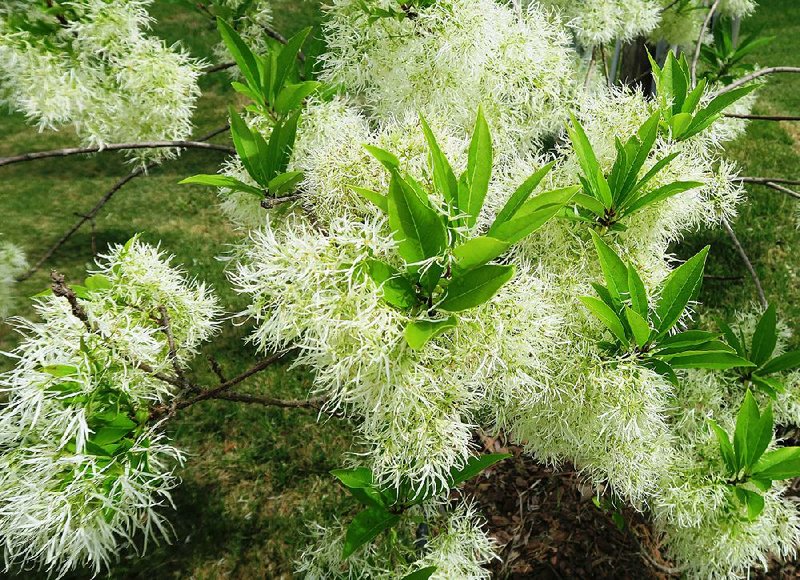THIS MONTH
• Where did spring go? The temperatures have been quite erratic, but the cooler weather has helped spring-blooming plants linger a bit. It has not been as kind to the heat lovers, so summer annuals, tropical flowering plants and warm-season vegetables are a bit on hold. Surely they will catch up quickly.
• Some parts of the state were nailed by bouts of hail, from mothball to tennis-ball size. If you see broken or damaged branches, leaves and stems, pruning off the damage using nice, clean cuts is your only line of defense. Leaving jagged wounds or broken branches can lead to decay and more damage.
• This winter was kinder to us than last winter, but it damaged some tender plants. Figs have some damage, as do some big-leaf (old-fashioned) hydrangeas. Prune out what has not started growing. Crape myrtles have been extremely slow to leaf out, especially in the northern tier of the state, but if you look closely, they are beginning to grow. Give them another couple of weeks of warm weather to leaf out and then assess the damage.
• Now is the time to prune spring bloomers that have stopped flowering. Don't just start cutting. Plan. Do you want perfect round "meatballs" or a more natural look? What height do you want the plants to be at the end of this season? If you prune to the expected height, you aren't leaving room for growth, so compensate. The sooner after flowering you prune, the better. This gives plants time to recover before hot weather hits, so they can set lots of blooms for next spring. Fertilize after pruning. Typically, one application of fertilizer per year is all trees and shrubs need.
• Forsythia is one spring-blooming plant that benefits from annual pruning. Here is a link to a new "I Dig Extension" blog with information on why and how to prune forsythia: uaex.edu/IDigExtension.
• The cool, wet weather has caused leaf gall on some azaleas and camellias. This thick, waxy growth can look awful, but it is more a nuisance than a hazard. Once warm weather appears, the disease will stop, but the remaining growths could re-infest the plants next season. Snap off the thickened foliage and dispose of it.
• Harvest is underway for cool-season vegetables, and there is still plenty of time to plant warm-season crops, including tomatoes, peppers, eggplants, squash, beans and more. Fertilize and water when dry. Mulching will also aid in moisture retention, while keeping weeds at bay. Remember, a minimum of six hours of sunlight is needed to grow vegetables.
• If you haven't visited a nursery lately, you are missing out. New plants arrive daily, in great variety.
• Winter annuals have lasted longer than normal with our cool spring, but you can gradually begin to replace them with summer annuals. Tropical flowering plants, from hibiscus and mandevilla to ixora and tibouchina, are available, too. These plants thrive in heat and humidity and give you nonstop color in the summer.
• Lawns have also been a bit slow to green up, so hold off on the first application of nitrogen fertilizer until the lawn is fully green. If you fertilized too soon, with all the rain we have been having, some of the nitrogen would run off before the lawn could use it.
• Perennials are looking great right now. Peonies are blooming beautifully, along with baptisia, amsonia and foxglove. Taller flowering perennials often need a little extra support from perennial stakes to help hold their blooms upright, especially in heavy rains.
PLANT OF THE MONTH
Fringe tree, Old Man's Beard or Grancy Gray Beard are three common names for Chionanthus virginicus. This is a wonderful native tree that is in full bloom now almost statewide.
The plant is dioecious , having separate male and female plants. If pollinated during bloom season, the female plant in the fall will put on small, bluish black berries, which birds love.
At maturity, fringe tree is a small tree or large shrub. It is a deciduous tree for full sun to partial shade that grows 12 to 20 feet tall. It can be grown as a single-trunk specimen, but more commonly we see fringe tree shrubs with multiple trunks.
Currently there are no pest problems, but it is a member of the olive family, and there is some concern that the emerald ash borer could pose a threat. Let's hope not.
Janet B. Carson is a horticulture specialist for the University of Arkansas Cooperative Extension Service.
HomeStyle on 05/02/2015
